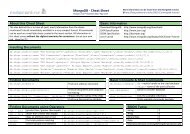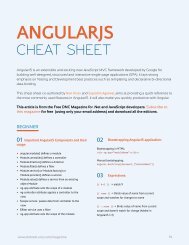build_your_own_angularjs_sample
build_your_own_angularjs_sample
build_your_own_angularjs_sample
Create successful ePaper yourself
Turn your PDF publications into a flip-book with our unique Google optimized e-Paper software.
Build Your Own Angular Chapter 1. Scopes And Digest<br />
On the top of the file we enable ES5 strict mode, and also let JSHint know it’s OK to refer<br />
to a global variable called Scope in the file.<br />
This test just creates a Scope, assigns an arbitrary property on it and checks that it was<br />
indeed assigned.<br />
It may concern you that we are using Scope as a global function. That’s definitely<br />
not good JavaScript style! We will fix this issue once we implement dependency<br />
injection later in the book.<br />
If you have Testem running in a terminal, you will see it fail after you’ve added<br />
this test case, because we haven’t implemented Scope yet. This is exactly what we<br />
want, since an important step in test-driven development is seeing the test fail first.<br />
Throughout the book I’ll assume the test suite is being continuously executed, and<br />
will not explicitly mention when tests should be run.<br />
We can make this test pass easily enough: Create src/scope.js and set the contents as:<br />
src/scope.js<br />
/* jshint globalstrict: true */<br />
'use strict';<br />
function Scope() {<br />
}<br />
In the test case we’re assigning a property (aProperty) on the scope. This is exactly how<br />
properties on the Scope work. They are plain JavaScript properties and there’s nothing<br />
special about them. There are no special setters you need to call, nor restrictions on<br />
what values you assign. Where the magic happens instead is in two very special functions:<br />
$watch and $digest. Let’s turn our attention to them.<br />
Watching Object Properties: $watch And $digest<br />
$watch and $digest are two sides of the same coin. Together they form the core of what<br />
the digest cycle is all about: Reacting to changes in data.<br />
With $watch you can attach a watcher to a scope. A watcher is something that is notified<br />
when a change occurs in the scope. You create a watcher by providing two functions to<br />
$watch:<br />
• A watch function, which specifies the piece of data you’re interested in.<br />
• A listener function which will be called whenever that data changes.<br />
6 ©2014 Tero Parviainen Errata / Submit




